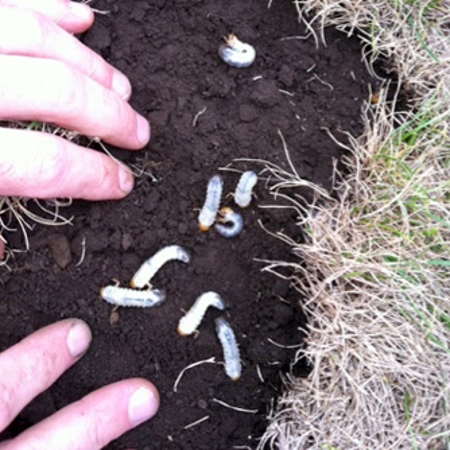Curl grubs
BackCurl grubs are the larvae of different species of beetle including the African Black Beetle, the blackheaded pasture cockchafer, Christmas beetles and Scarab beetles. The larvae feed on dead plant material and the live roots or stems of a broad range of plants including lawns. They are white or pale cream in colour with a brown head and greyish end. They grow to around 2.5cm long and are sometimes mistaken for witchetty grubs. It is their habit of curling up into a “C” shape that gives them their common name.
As the curl grubs feed, plants and lawns fail to perform well and often appear to need watering despite the ground still being moist. In heavy infestations brown patches will appear in a lawn and the grass when pulled will come away in handfuls. In pots, a heavy infestation of curl grubs can eat the entire root system of a plant.
It is during warmer weather that new eggs hatch and older larvae move closer to the soil surface feeding more heavily on plant roots. The hotter weather adds to the burden of plants trying to survive with a diminishing root ball. As such Spring and Summer are generally the best times to treat lawns and garden beds. Potted plants may suffer at any time of the year.
Infestation levels are usually worse after prolonged periods of very dry, hot weather.
Plants Attacked
Curl grubs will feed on the roots of a wide range of plants with the exception of legumes (eg beans and peas). Damage is most noticeable in lawns where large dead patches appear as the summer progresses. Potted plants are vulnerable as their root system is limited by the pot size and any loss will affect growth more than if they were in the ground. For plants in garden beds they may simply fail to thrive for no apparent reason, until you dig up the soil and find loads of curl grubs!
Organic Control Methods for Curl Grub
- Apply eco-neem to lawns, garden beds and potted plants as a soil drench using a watering can. Optimum application time is between mid Spring to mid Summer when the eggs are hatching and larvae are near the surface of the soil. Ensure thorough coverage of treated areas.
- Where practical turnover the soil to expose the curl grubs. Remove them by hand and feed to the birds. They love them!
- Minimise the use of outdoor night lighting as this may attract the adult beetles into the area.
Please note that coming across one or two curl grubs in a garden bed is usually no cause for alarm. It is only when you discover larger numbers that significant damage occurs and treatment is required. With potted plants however they should always be controlled regardless of the number you find.





